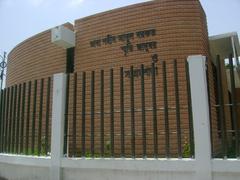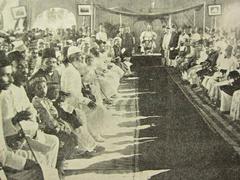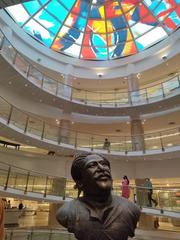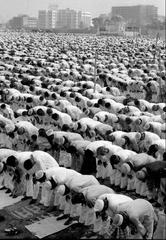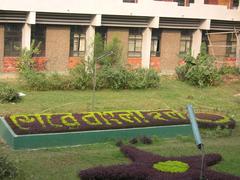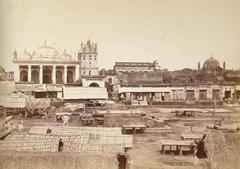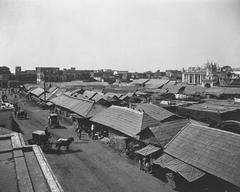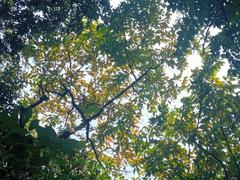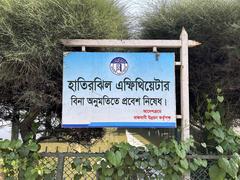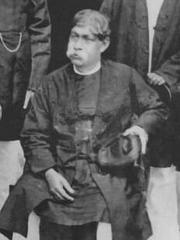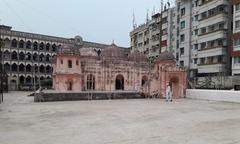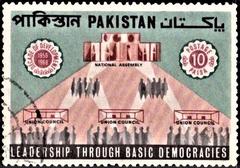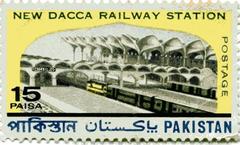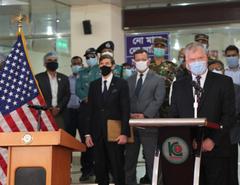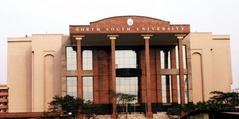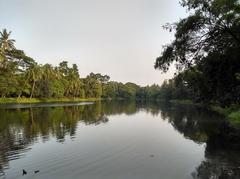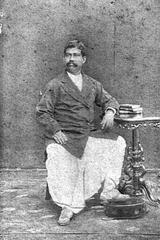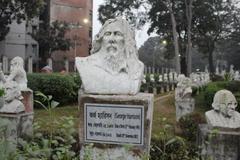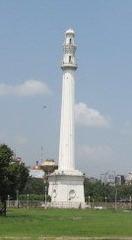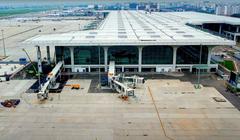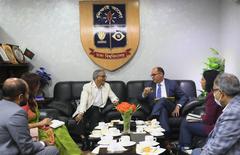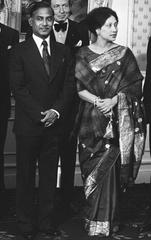University of Asia Pacific Dhaka Visiting Hours, Tickets, and Historical Overview
Date: 15/06/2025
Introduction
Nestled in Dhaka’s bustling urban core, the University of Asia Pacific (UAP) stands as a prominent institution for higher education in Bangladesh. Since its inception in 1996 under the Private University Act of 1992, UAP has grown from modest beginnings to host a wide array of faculties, including Engineering, Science, Business, Arts and Humanities, Law, and Pharmacy. Its central campus at 74/A, Green Road, Farmgate is renowned both for academic innovation and for fostering social responsibility among students (QS China; StudyBarta).
This guide details UAP’s historical development, academic structure, visitor information (including hours and accessibility), and highlights Dhaka’s iconic Ahsan Manzil—the Pink Palace—another must-see for those exploring the city’s educational and cultural landscape. Whether you are a prospective student, a visiting scholar, or a cultural enthusiast, read on for practical information and expert tips.
Table of Contents
- Introduction
- Founding and Early Development
- Institutional Vision and Mission
- Growth and Academic Expansion
- Campus Location and Visitor Information
- Academic Recognition and Rankings
- Social and Educational Impact
- UAP’s Role in Higher Education
- FAQs
- Academic Structure and Programs
- Research, Innovation & Industry Ties
- International Collaboration
- Admission Process and Student Demographics
- Facilities and Student Life
- Visual and Media Resources
- University of Asia Pacific: Visitor Information
- Ahsan Manzil: Visiting Hours, Tickets, and Historical Overview
- Conclusion and Call to Action
- Sources and Official Links
Founding and Early Development
UAP was established in 1996 by the University of Asia Pacific Foundation, a non-profit comprising leading educationists and administrators, with a mission to advance higher education and foster national progress (QS China; Simple Wikipedia). Initially, the university offered four-year bachelor’s programs in Computer Science and Business Administration, approved by the University Grants Commission (UGC) (StudyBarta). With time, the curriculum expanded to include Architecture, Civil Engineering, Pharmacy, and other key disciplines.
Institutional Vision and Mission
UAP’s core vision is to provide quality tertiary education that prepares students for both national and global job markets. The university emphasizes critical thinking, lifelong learning, ethical values, and civic responsibility (QS China).
Growth and Academic Expansion
From its inception, UAP has evolved to offer nine undergraduate and eight postgraduate programs, with the School of Business playing a pivotal role in academic growth and the introduction of MBA and EMBA degrees (UAP School of Business). The university blends liberal education with technical and professional training, ensuring graduates are well-equipped for a dynamic, fast-changing world (Simple Wikipedia).
Campus Location and Visitor Information
Location and Accessibility
UAP’s main campus is situated at 74/A, Green Road, Farmgate, Dhaka—an area known for its vibrant city life and excellent connectivity (StudyBarta). The university is spread across several rented premises, all easily reachable by public transport.
Visiting Hours
- Weekdays: Sunday–Thursday, 9:00 AM–5:00 PM
- Weekends: Visits by prior arrangement only
Campus Tours & Facilities for Visitors
Guided tours can be arranged for prospective students and guests. These tours cover academic buildings, libraries, and student facilities. Contact the admissions office in advance to book a slot.
Accessibility Provisions
UAP is committed to inclusive access, providing ramps and elevators in major buildings to support visitors with mobility challenges.
Nearby Attractions
Located in Farmgate, visitors can explore nearby eateries, bookstores, and access cultural centers and parks, making a trip to UAP part of a broader Dhaka experience.
Academic Recognition and Rankings
UAP consistently ranks among Bangladesh’s top private universities. The 2021 SCImago Institution Ranking placed UAP in the top five private institutions nationwide (UAP School of Business). Engineering and pharmacy programs are accredited by relevant national bodies.
Social and Educational Impact
UAP’s curriculum and campus culture emphasize ethical education, social responsibility, and community engagement (QS China), producing graduates who contribute meaningfully to society.
UAP’s Role in Higher Education
As one of the first private universities under the 1992 Act, UAP set benchmarks for academic quality, governance, and societal engagement, influencing the evolution of private higher education in Bangladesh (Simple Wikipedia).
Frequently Asked Questions (FAQs)
Q: How do I apply for undergraduate programs?
A: Applicants must have completed higher secondary education. Program-specific requirements and deadlines are on the official UAP website.
Q: Are campus tours available?
A: Yes, by contacting the admissions office to schedule during official hours.
Q: Does UAP offer scholarships?
A: Merit- and need-based scholarships are available. Check the scholarships page for details.
Q: How accessible is the campus?
A: UAP provides ramps and elevators for visitors with disabilities.
Q: What transport options are nearby?
A: Public buses, rickshaws, and ride-sharing services all serve the Farmgate area.
Academic Structure and Programs
Governance and Organization
UAP is overseen by a Board of Trustees and Academic Council, ensuring academic integrity and excellence. Faculties are led by deans, with departments managing programs and research.
Faculties and Departments
Faculties for 2024–2025 include:
- Engineering
- Science
- Business
- Arts and Humanities
- Law
- Pharmacy
Departments cover Civil Engineering, Computer Science, Business Administration, English, Law, and more.
Undergraduate and Postgraduate Programs
Key undergraduate degrees:
- BSc Civil Engineering
- BSc Computer Science & Engineering
- BArch (Architecture)
- BBA (Business Administration)
- BPharm (Pharmacy)
- LLB (Law)
- BA English
Postgraduate programs:
- MSc Civil Engineering
- MSc Computer Science & Engineering
- MBA
- LLM
- MPharm
Engineering and pharmacy programs are accredited by national professional bodies.
Academic Calendar and Credit System
UAP follows a semester system: Spring (January), Fall (July), and a shorter Summer session. Undergraduates complete 120–160 credits; postgraduates, 36–60 credits (UAP Academic Calendar).
Research, Innovation & Industry Ties
UAP supports research through dedicated centers and mandatory theses in engineering and architecture. Industry linkages include internships, advisory boards, and regular career fairs.
International Collaboration
The university maintains student exchange programs and collaborative research with universities in Asia, Europe, and North America.
Admission Process and Student Demographics
Admission is competitive, based on academic merit and entrance exams. UAP enrolls more than 7,000 students from across Bangladesh and neighboring countries.
Facilities and Student Life
- Central and departmental libraries
- State-of-the-art laboratories
- E-learning platforms
- Over 20 student clubs (debate, robotics, entrepreneurship, cultural, etc.)
- Counseling, health, and career services
Visual and Media Resources
- UAP Campus Virtual Tour (alt: “University of Asia Pacific Dhaka campus aerial view”)
- UAP Instagram page for event and student life highlights
University of Asia Pacific: Visitor Information Summary
- Location: 74/A, Green Road, Farmgate, Dhaka
- Visiting Hours: 9:00 AM–5:00 PM, Sunday–Thursday
- Contact: Admissions office (for tours)
- Accessibility: Fully accessible campus
- Nearby: Banani Lake, Gulshan Lake Park, local cafes
Ahsan Manzil: Visiting Hours, Tickets, and Historical Overview
Introduction
Ahsan Manzil, known as the Pink Palace, is a hallmark of Dhaka’s architectural and cultural heritage. Located on the Buriganga River’s banks, this 19th-century palace was the official residence of the Nawabs of Dhaka and now serves as a national museum.
Historical and Cultural Significance
Ahsan Manzil was constructed in the late 1800s by Nawab Abdul Ghani and later named after Nawab Ahsanullah. Its Indo-Saracenic architecture combines Mughal and European influences, reflecting Dhaka’s aristocratic legacy. The palace played a central role in the city’s social and political life during British rule, and today, its museum preserves artifacts and photographs from the Nawabi era (Department of Archaeology, Bangladesh; Bangladesh National Museum).
Visitor Information
Opening Hours
- Open: Saturday to Thursday, 10:00 AM–5:00 PM
- Closed: Fridays and public holidays
Ticket Prices
- Bangladeshi Citizens: 30–60 BDT
- Foreign Tourists: 200 BDT
- Children under 12: Free
(Tickets available at entrance or online via Bangladesh National Museum)
Guided Tours and Audio Guides
Daily guided tours are available in English and Bengali. Audio guides and brochures enhance the visitor experience, providing context on the palace’s history and architecture.
Getting There and Accessibility
Ahsan Manzil is located in Shadarghat, Old Dhaka, near the Buriganga River ferry terminal. The site is accessible by rickshaw, taxi, or bus from anywhere in the city. Ramps and accessible pathways are available for visitors with disabilities.
Nearby Attractions
- Lalbagh Fort: 17th-century Mughal fort complex
- Dhakeshwari Temple: Bangladesh’s national temple
- Sadarghat Riverfront: Bustling river port and boat tours
Best Time to Visit
Visit during the cooler months (November–February) or in the early morning/late afternoon to avoid crowds and heat.
Photography and Events
Photography is allowed (without flash) in designated areas. The palace regularly hosts cultural exhibitions and programs during national holidays and festivals.
FAQs
Q: Is Ahsan Manzil suitable for children?
A: Yes, with adult supervision in some exhibit areas.
Q: Are pets allowed?
A: No, except service animals.
Q: Is parking available?
A: Limited parking; public transport is recommended.
Q: Can I purchase souvenirs?
A: Yes, a gift shop offers handicrafts and books.
Conclusion
Ahsan Manzil offers a fascinating journey into Dhaka’s aristocratic past and architectural artistry. Coupled with nearby attractions, it is a must-visit for anyone interested in Bangladesh’s rich history and culture. For up-to-date information, tour bookings, and event schedules, visit the official museum website or follow Dhaka’s heritage social media channels.
Summary: Visiting UAP Dhaka & Ahsan Manzil
The University of Asia Pacific embodies the evolution of Bangladesh’s private higher education sector—offering accredited academic programs, vibrant student life, and accessible facilities in a prime city location (QS China; UAP School of Business). Ahsan Manzil, meanwhile, provides a vivid window into Dhaka’s royal and colonial past through its architecture and museum collections (Department of Archaeology, Bangladesh; Bangladesh National Museum). Together, these sites create a unique blend of modern academic achievement and heritage tourism, making Dhaka a compelling destination for students and travelers alike.
For more details, guided tours, and continuous updates, consult the official websites, download the Audiala app, and engage with related social media platforms.
Sources and Official Links
- QS China
- StudyBarta
- UAP School of Business
- UAP Academic Calendar
- Department of Archaeology, Bangladesh
- Bangladesh National Museum
- UAP Official Website
- UAP Instagram
